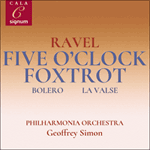At the end of June 1922 Ravel went to London with the pianist Robert Casadesus and his wife Gaby to make some recordings for the Aeolian company. He was also able to hear the first British performance of his Duo for violin and cello in which the violinist was the Hungarian Jelly d’Arányi. Afterwards, he got d’Arányi to play him some gypsy folk music and, according to Gaby: ‘D’Arányi, being Hungarian, didn’t need to be asked twice and played passionately for at least two hours without stopping. She was sensational and Ravel was mad with joy … very shortly afterwards
Tzigane was born.’ D’Arányi gave the first performance in April 1924 in London. The piece adopts the slow/fast (lassú/friss) form of the csárdás, the slow section being for violin alone. In imitating the gypsy style—harmonics, trills, glissandos, appoggiaturas, hesitations and passages in high positions on the lower strings—Ravel may have left something of himself behind, but as pastiche it is undeniably brilliant, drawing some of its ideas from Liszt’s Hungarian Rhapsodies and Paganini’s Caprices. When d’Arányi was rehearsing for a performance with orchestra in Paris that November, she is said to have introduced what she called a ‘glissando with trills’. Ravel supposedly confided to a friend, ‘I don’t know what she’s doing, but I like it.’
from notes by Roger Nichols © 2011
À la fin de juin 1922, Ravel se rendit à Londres avec le pianiste Robert Casadesus et sa femme Gaby en vue de graver quelques enregistrements pour la firme Aeolian. Il put aussi entendre la première britannique de son Duo pour violon et violoncelle, avec la violoniste hongroise Jelly d’Arányi, à laquelle il demanda peu après de lui jouer de la musique tzigane. Selon Gaby: «D’Arányi, qui était hongroise, ne se fit pas prier et joua avec passion pendant au moins deux heures, sans interruption. Elle fut éblouissante et Ravel, fou de joie … Très peu de temps après naissait
Tzigane.» Cette pièce, créée par d’Arányi en avril 1924, à Londres, adopte la forme lent/rapide (lassú/friss) des csárdás, la section lente étant dévolue au violon seul. En imitant le style tzigane—harmoniques, trilles, glissandi, appoggiatures, hésitations et passages en positions hautes, aux cordes inférieures—, Ravel a peut-être abandonné une part de lui-même, mais le pastiche est indéniablement brillant, qui puise certaines idées dans les Rhapsodies hongroises de Liszt comme dans les Caprices de Paganini. Ce novembre-là, un jour qu’elle répétait à Paris, en vue d’une exécution avec orchestre, d’Arányi aurait introduit ce qu’elle appela un «glissando avec trilles». «J’ignore ce qu’elle est en train de faire, mais ça me plaît», aurait alors confié Ravel à un ami.
extrait des notes rédigées par Roger Nichols © 2011
Français: Hypérion
Ende Juni 1922 reiste Ravel mit dem Pianisten Robert Casadesus und dessen Frau Gaby nach London, um einige Werke für die Aeolian Company einzuspielen. Außerdem konnte er die erste britische Aufführung seines Duos für Violine und Violoncello mit der ungarischen Geigerin Jelly d’Arányi hören. Danach bat er d’Arányi, ihm Zigeuner-Volksmusik vorzuspielen und Gaby Casadesus zufolge „ließ sich d’Arányi, als Ungarin, nicht zweimal bitten und spielte mindestens zwei Stunden lang ohne Unterbrechung und mit großer Leidenschaft. Sie war sensationell und Ravel war vor Freude verrückt … kurz danach entstand
Tzigane.“ D’Arányi gab die erste Aufführung in London im April 1924. Das Stück ist in der langsam/schnell-Form (lassú/friss) des Csárdás gehalten, wobei der langsame Teil für Violine allein komponiert ist. Mit seiner Imitation des Zigeunerstils—Flageolett, Triller, Glissandi, Appoggiaturen, Zögern und Passagen in hohen Positionen auf den tieferen Saiten—mag Ravel seinen eigenen Stil vernachlässigt haben, doch ist es als Pasticcio zweifellos brillant und bezieht sich zum Teil auf Liszts Ungarische Rhapsodien und Paganinis Caprices. Als d’Arányi anlässlich eines Konzerts mit Orchester im November des Jahres in Paris probte, soll sie ein „Glissando mit Trillern“ eingeführt haben. Ravel soll sich daraufhin an einen Freund gewandt und gesagt haben: „Ich weiß zwar nicht, was sie macht, aber es gefällt mir.“
aus dem Begleittext von Roger Nichols © 2011
Deutsch: Viola Scheffel


 Ravel: Five o'clock foxtrot & other orchestral works
Ravel: Five o'clock foxtrot & other orchestral works
